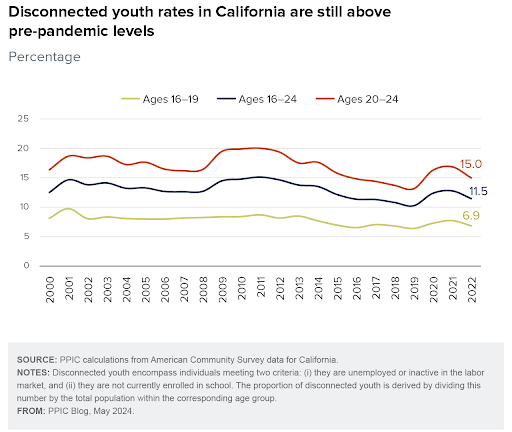Without School or Work, Some California Youth Are Left Disconnected from the Economy
This article is reprinted from the Public Policy Institute of California PPIC), Blog Post on May 8, 2024, Author-Daniel Payares-Montoya
https://www.ppic.org/blog/without-school-or-work-some-california-youth-are-left-disconnected-from-the-economy/
A widespread belief that California’s children will face a bleak economic future is supported by worrying numbers: the rising share of “disconnected youth” (also known as “opportunity youth”)—those not in school or not employed and not looking for a job—across all gender and race/ethnic groups. To thwart this grim trend, young Californians need avenues to economic opportunity through education and employment.
In 2022, close to 11.5% of the state’s youth, or nearly half a million Californians aged 16 to 24, were not in schoolnor participating in the labor market. This marked the highest number of individuals among all states and the 22nd highest rate nationwide. While the rate declined in 2022, it remains above pre-pandemic levels, given a sharp increase in 2019 and 2020. Enrollment declines in K–12 and higher education, in part driven by pandemic-related forces, contributed to this upswing.
Californians aged 20 to 24 represent almost three-quarters of all youth disconnected from school and employment. By age group, 15% of those between 20 and 24 are disconnected, or double the share of those between 16 and 19 (7%). This higher share stems from unemployment rates among older youth that are almost triple that of younger youth and labor force nonparticipation rates that are double. (Fig. 1)
Over the last two decades, gender gaps have reversed among disconnected youth in California. In 2002, young women were almost six out of ten of those disconnected from school and employment—a decade later, they were just over 50%; in 2022, young men had become 53% of the disconnected. For those between 16 and 19, gender imbalances today are even more pronounced (42% for women vs 58% for men). The escalating gender gaps in educational attainment—in English and math test scores in grades 3–8, stronger high school records, or completion of college-preparatory courses—can emerge well before the college years and offer a plausible explanation for these shifts; they also suggest wider disparities to come. (Fig. 2)
Disparities also extend across racial and ethnic groups. While in 2022 nearly one out of five young Black Californians aged 16 to 24 were disconnected from school and employment, only 8% of all Asians were. Disconnection is notable among Black males across all ages, with 20% disconnected (Latino: 13%; multiethnicity: 12%; white: 11%; Asian: 9%). Furthermore, Black and Latino youth are overrepresented in the disconnected demographic at 64% of the total, despite making up 55% of young adults in California. (Fig. 3)



Various factors contribute to youth disconnected rates. Some young adults may be unable to find educational opportunities or employment, while others choose to drop out of school or the workforce for personal, family, or financial reasons. Disconnected youth may come from communities that are also disconnected from opportunity—for instance by residential segregation or concentrated disadvantage—and mirror school or employment struggles faced by their parents and neighbors.
Compounding these issues, early career conditions may leave lasting imprints on employment and wages; so being disconnected from the labor market in pivotal early adult years can have consequences over the long term. Again, these impacts are likely to be concentrated among young Black and Latino Californians. The rise in disconnection during the pandemic may worsen this trend.
Considering these individual and systemic challenges, early efforts at promoting educational and economic options for young Californians are critical. Efforts should include making sure students graduate from high school, connect to effective postsecondary education or training pathways, and benefit from career counseling and job matching. Support along these avenues can help young Californians avoid falling through the cracks in today’s economy during the decisive years that shape their longer-term outcomes.


